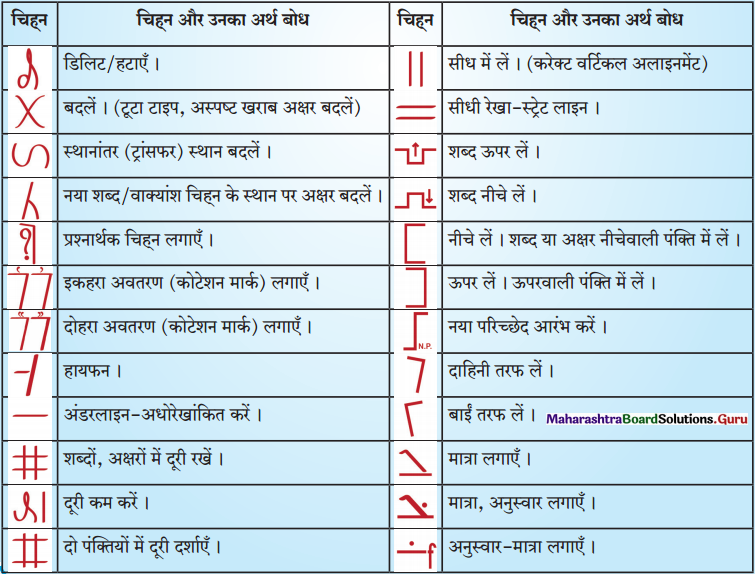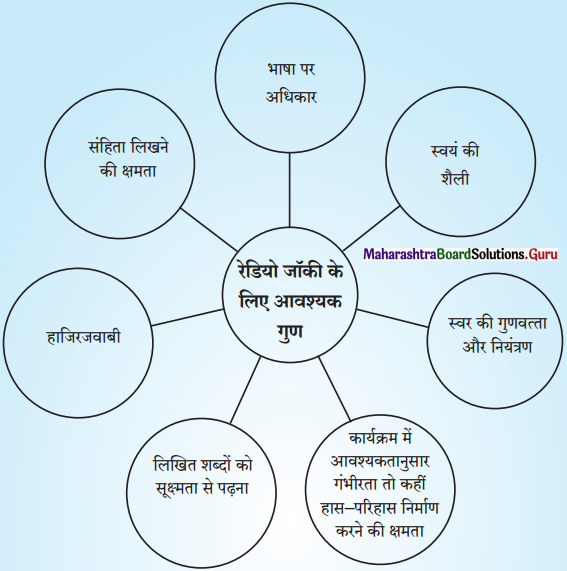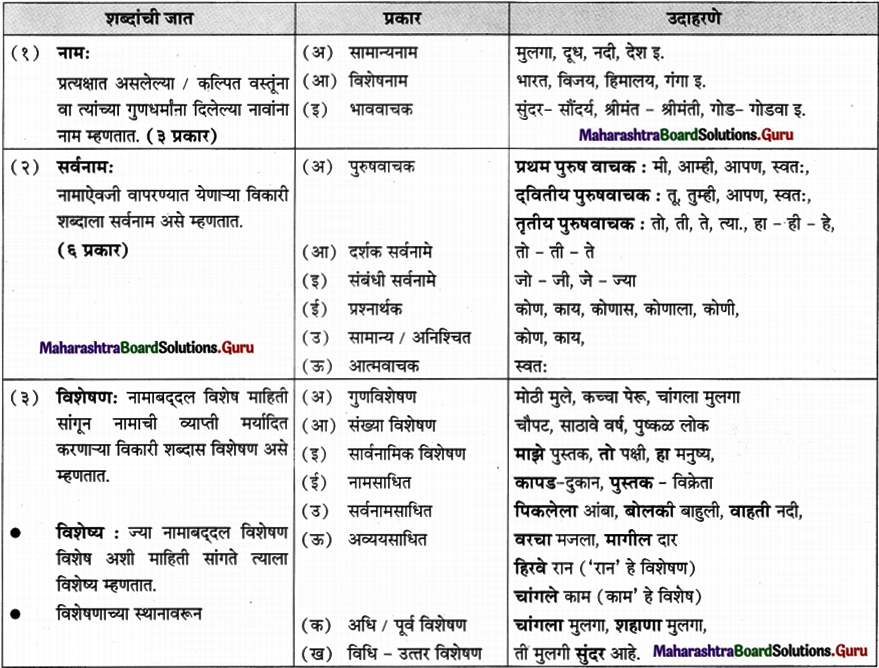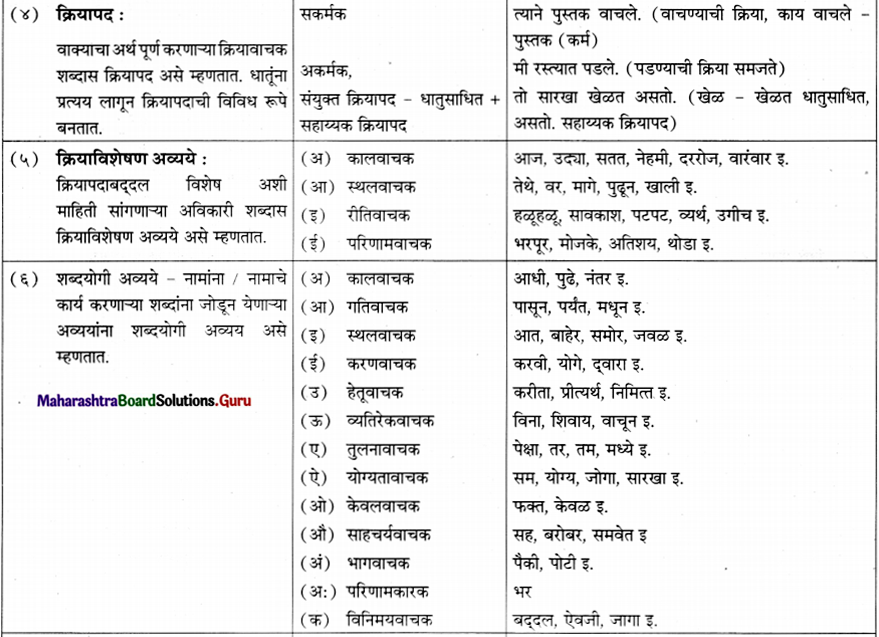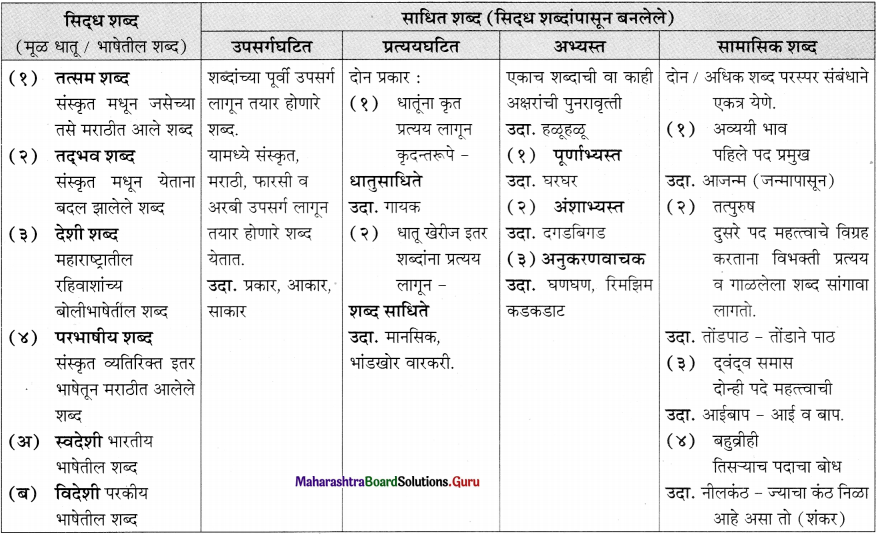Balbharti Maharashtra State Board Marathi Yuvakbharati 11th Digest व्याकरण विरामचिन्हे Notes, Textbook Exercise Important Questions and Answers.
Maharashtra State Board 11th Marathi Yuvakbharati Solutions व्याकरण विरामचिन्हे
विरामचिन्हे प्रास्ताविकः
आपल्या बोलण्याचा आशय ऐकणाऱ्याला चांगल्या रीतीने समजावा म्हणून आवाजाच्या चढ-उताराबरोबरच एखाद दुसऱ्या ठिकाणी आपण काही क्षण थांबतो या थांबण्यालाच ‘विराम’ असे म्हणतात.
बोलण्यातील विराम लेखनात निरनिराळ्या चिन्हांनी दर्शविला जातो. अशा लेखनातील विविध चिन्हांना ‘विरामचिन्हे’ असे म्हणतात.
विरामचिन्हांमुळे वाक्य कोठे संपले, कोठे सुरू झाले की अपूर्ण आहे अशा विविध गोष्टी आपणास समजतात. म्हणूनच विरामचिन्हांना लेखनात अत्यंत महत्त्व आहे.
![]()
विरामचिन्हे दोन प्रकारची आहेत.
- विराम दर्शवणारी
- अर्थबोध करणारी
विराम दर्शवणारी :
- पूर्णविराम ( . ),
- अर्धविराम ( ; ),
- स्वल्पविराम ( , ),
- अपूर्णविराम ( : ).
अर्थबोध करणारी :
- प्रश्नचिन्ह ( ? ),
- उद्गारचिन्ह ( ! ),
- अवतरण चिन्ह (” ” दुहेरी व ” एकेरी),
- संयोगचिन्ह ( – ),
- अपसारण चिन्ह ( – )
- याशिवाय लोप चिन्ह ( ……… ),
- अधोरेखा चिन्ह ( अ ),
- विकल्प चिन्ह ( / ),
- काकपद/हंसपद ( , ),
- कंस () साधा कंस,
- { } महिरप कंस,
- [ ] चौकोनी कंस),
- वरीलप्रमाणे मजकूर / यथोपरिचिन्ह (” “, -।।-)
- अवग्रह (ऽ) उच्चार लांब करण्यासाठी,
- फुल्या (xxx) (अवशिष्ट व अयोग्य मजकुरासाठी),
- दंड ( । एकेरी, ।। दुहेरी) ही लेखनात वापरली जातात.
![]()
11th Marathi Book Answers व्याकरण विरामचिन्हे Additional Important Questions and Answers
1. खालील वाक्यांत योग्य त्या ठिकाणी विरामचिन्हे देऊन वाक्ये पुन्हा लिहा.
प्रश्न 1.
सर पोराचं लग्न हाय यायला पाहिजे.
उत्तर :
“सर, पोराचं लग्न हाय. यायला पाहिजे.”
प्रश्न 2.
ते म्हणाले गेले दोन दिवस मेघदूत वाचत होतो.
उत्तर :
ते म्हणाले, “गेले दोन दिवस, ‘मेघदूत’ वाचत होतो.”
प्रश्न 3.
मी सोपानदेवांना म्हणालो अहो हे बावनकशी सोने आहे
उत्तर :
मी सोपानदेवांना म्हणालो, “अहो, हे बावनकशी सोने आहे!”
प्रश्न 4.
वडील सहा आठ महिने दौऱ्यावर
उत्तर :
वडील सहा-आठ महिने दौऱ्यावर.
प्रश्न 5.
ड्रायव्हरनं गाडी सुरू केली आणि विचारलं कुठे जायचं
उत्तर :
ड्रायव्हरनं गाडी सुरू केली आणि विचारलं, “कुठे जायचं?”
2. पुढील वाक्यांत योग्य विरामचिन्हांचा पर्याय निवडून वाक्ये पुन्हा लिहा.
प्रश्न 1.
रसिकहो वहिानींचा सल्ला या कार्यक्रमाचा आजचा शेवटचा प्रयोग.
पर्याय :
(अ) उद्गारवाचक चिन्ह, एकेरी अवतरण
(आ) प्रश्नचिन्ह, उद्गारवाचक चिन्ह
(इ) दुहेरी अवतरण चिन्ह, स्वल्पविराम
उत्तर :
(अ) उद्गारवाचक चिन्ह, एकेरी अवतरण (रसिकहो! ‘वहिनींचा सल्ला’ या कार्यक्रमाचा आजचा शेवटचा प्रयोग)
प्रश्न 2.
पायच होऊ देत आता घट्ट मजबूत पोलादी पर्याय :
![]()
(अ) प्रश्नचिन्ह, लोपचिन्ह
(आ) स्वल्पविराम, अर्धविराम
(इ) लोपचिन्ह, स्वल्पविराम
उत्तर :
पर्याय : (इ) लोपचिन्ह, स्वल्पविराम (पायच होऊ देत आता… घट्ट, मजबूत, पोलादी)
प्रश्न 3.
जी ए कुलकर्त्यांचा एखादा कथासंग्रह तुम्ही वाचला आहे काय पर्याय :
(अ) स्वल्पविराम, अर्धविराम
(आ) पूर्णविराम, प्रश्नचिन्ह
(इ) अपूर्णविराम, अवग्रहचिन्ह
उत्तर :
(आ) पूर्णविराम, प्रश्नचिन्ह (जी. ए. कुलकर्त्यांचा एखादा कथासंग्रह तुम्ही वाचला आहे काय?)
